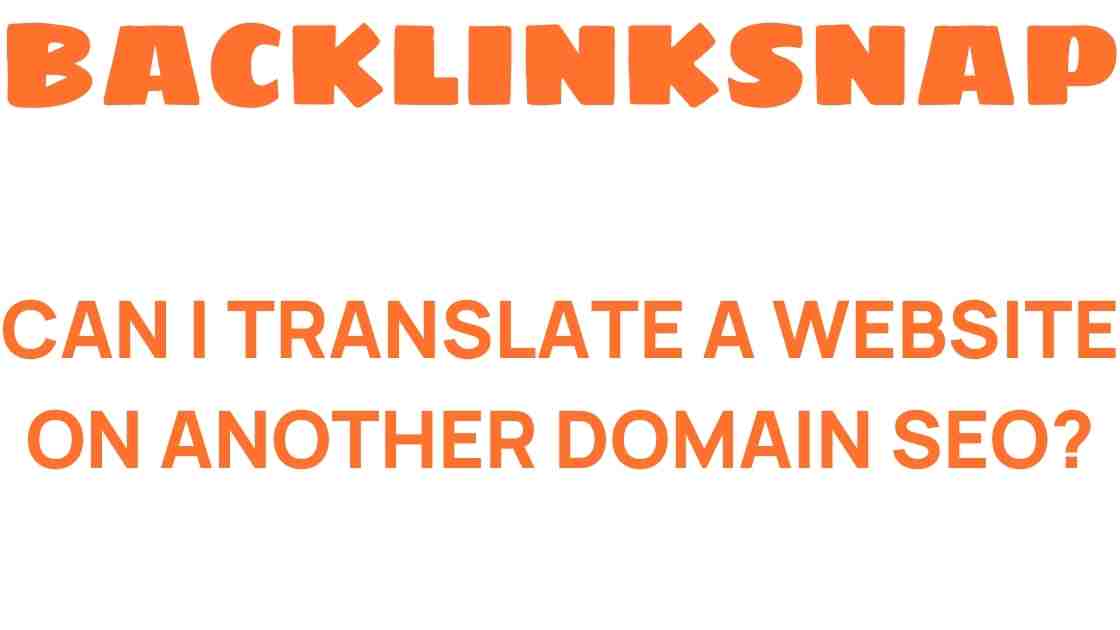Can I Translate a Website on Another Domain for SEO Success?
In today’s globalized world, website translation has become a critical component of effective digital marketing strategies. Businesses aiming to reach international markets often ponder the best ways to translate their websites while still adhering to sound SEO strategies. One question that frequently arises is whether it’s possible to translate a website hosted on another domain and still achieve SEO success. In this article, we’ll explore the intricacies of multilingual SEO, the implications of domain translation, and the benefits of optimizing your content for an international audience.
The Importance of Website Translation for SEO
When considering international SEO, one must understand that merely translating text is not enough. Effective content localization goes beyond direct translation; it requires cultural adaptation, ensuring that the content resonates with the target audience. This can significantly enhance your search engine ranking in different languages and regions.
The benefits of a well-translated website are manifold:
- Increased Reach: By providing content in multiple languages, you can attract a broader audience.
- Improved User Experience: Users are more likely to engage with content that is in their native language.
- Higher Conversion Rates: A localized website can lead to increased sales and leads, as users feel more comfortable navigating content in their language.
Understanding Domain Translation
When it comes to domain translation, you have a few options. You can either create a new domain for each language or use subdomains or subdirectories. Each method has its pros and cons, and your choice can impact your site’s SEO performance.
- Separate Domains: For example, using example.fr for French and example.de for German. This approach can be beneficial for branding but might dilute your SEO efforts, as each domain will have to build its own authority.
- Subdomains: Using fr.example.com or de.example.com keeps your primary domain intact while allowing for distinct language versions. This method can help maintain some SEO strength from your main site.
- Subdirectories: This method involves using example.com/fr/ or example.com/de/. It’s often considered the most SEO-friendly option as it allows you to leverage the existing authority of your main domain while still providing localized content.
Key SEO Strategies for Multilingual Websites
To optimize your translated website for search engines, consider the following strategies:
- Hreflang Tags: Implement hreflang tags to guide search engines on which version of a page to serve based on the user’s language and region.
- Keyword Research: Conduct thorough keyword research for each language and region. What works in one language may not in another, so adapt your strategy accordingly.
- Localized Content: Ensure that your content is not just translated but also culturally relevant to your audience. This includes idioms, references, and even visuals.
- Link Building: Focus on building backlinks from reputable sites within your target language’s domain. This can enhance your search engine ranking significantly.
The SEO Benefits of Website Translation
Investing in website translation can yield numerous SEO benefits. Here are a few:
- Enhanced Visibility: A multilingual site can rank in multiple languages, increasing your visibility across different markets.
- Competitive Advantage: Many businesses haven’t yet optimized for non-English speaking audiences, giving you a head start in those markets.
- Better Engagement Metrics: Localized content tends to have lower bounce rates and higher engagement, signaling to search engines that your site is valuable.
- Audience Trust: Users are more likely to trust and engage with sites that communicate in their language, improving overall brand perception.
Measuring the Performance of Your Translated Website
After launching your translated website, it’s crucial to track its performance. Utilize tools like Google Analytics to monitor traffic, user behavior, and engagement metrics across different language versions. Look for:
- Traffic sources and volumes
- Conversion rates per language
- User engagement metrics like bounce rates and time on page
By analyzing these metrics, you can continuously optimize your multilingual SEO strategy, ensuring that your translated websites are not just live but thriving.
Conclusion
In conclusion, translating a website on another domain can indeed lead to SEO success if done correctly. By leveraging the right SEO strategies, focusing on content localization, and choosing the appropriate domain structure, businesses can effectively reach international audiences. The key is to ensure that the translation process is thorough and culturally appropriate while adhering to best practices for SEO. As you embark on this journey, remember that the rewards are well worth the effort—an expanded audience, improved engagement, and ultimately, greater success in the global marketplace.
FAQs
- Can I use Google Translate for website translation?
While Google Translate can provide a quick translation, it is not ideal for professional use. Automated translations often lack the nuance and cultural context necessary for effective communication. - What is the best structure for a multilingual website?
Using subdirectories (e.g., example.com/fr/) is often recommended for SEO, as it allows you to leverage the authority of your main domain. - How can I improve my multilingual SEO?
Focus on keyword research for each language, implement hreflang tags, and ensure your content is culturally relevant. - Do I need different SEO strategies for different languages?
Yes, each language may have different keywords, competitive landscapes, and cultural nuances that require tailored strategies. - Is it necessary to translate all website content?
Prioritize high-traffic and high-conversion pages first, then consider translating other content based on user demand. - How long does it take to see results from multilingual SEO?
Results can vary, but it generally takes several months to see significant changes in traffic and conversions from translated pages.
For more information on optimizing your website for international audiences, you can check out this detailed guide on multilingual SEO. Additionally, learn more about content localization strategies to ensure your website resonates with users worldwide.
This article is in the category SEO Optimization and created by BacklinkSnap Team




